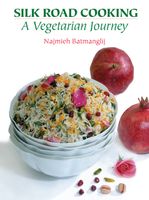Advertisement
Asafetida
Appears in
Published 2000
This spice, a dried gem resin obtained from the taproots of certain giant fennels, has been used since ancient times from the Mediterranean to Central Asia as a flavoring. The name comes from the Persian asa, or “mastic resin,” and the Latin foetida, or “stinking,” a reference to its pungent smell. It is available at Asian markets, usually in one of two forms. The best is “lump” asafetida, a mass of tiny pellets, or “tears.” This may be powdered and mixed with such spices as turmeric in an attempt to reduce its odor; however, powdered asafetida produces a powerful, sulphurous smell that will pervade your kitchen. I advise buying the lump form shown below, which has little odor. Add asafetida to hot oil and allow it to fry for 2 seconds before you add other ingredients. The spice then acquires the scent of onions, for which it is often a substitute in Indian cooking, particularly among Jains, who do not eat root vegetables. Asafetida rounds out the flavor of other vegetables. It is also said to eliminate gas caused by legumes and help digestion.


